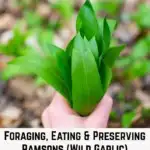
In the forest, just before delicate spring buds at the ends of tentative branches begin to gently open, life on the forest floor is already awakening.
You may even catch a whiff of it before you see it, if the wind is blowing just right. The heavenly-earthy scent of ramsons.
Remember to use all of your foraging senses, and animal instincts, while out in the woods: touch, sight, hearing, smell and taste. Keeping in mind that everything is edible, though some things only once, such is the case when foraging for mushrooms.
Of course, when harvesting from the wild, you’ll want to know a thing or two about best harvesting practices. If you are new to foraging, it may even be beneficial to take a foraging class or go out with someone who knows exactly what they are harvesting (and eating) before going out on your own.
Sooner or later, you will discover that ramsons are not only found in the forests, they can be tamed too! And they make an excellent addition to the perennial shade-loving plants in your garden.
Once you come upon a generous green patch of wild garlic, you’ll never forget it! Luckily you can return to the same spot year after year, as wild garlic spreads by persistent bulbs and seeds.
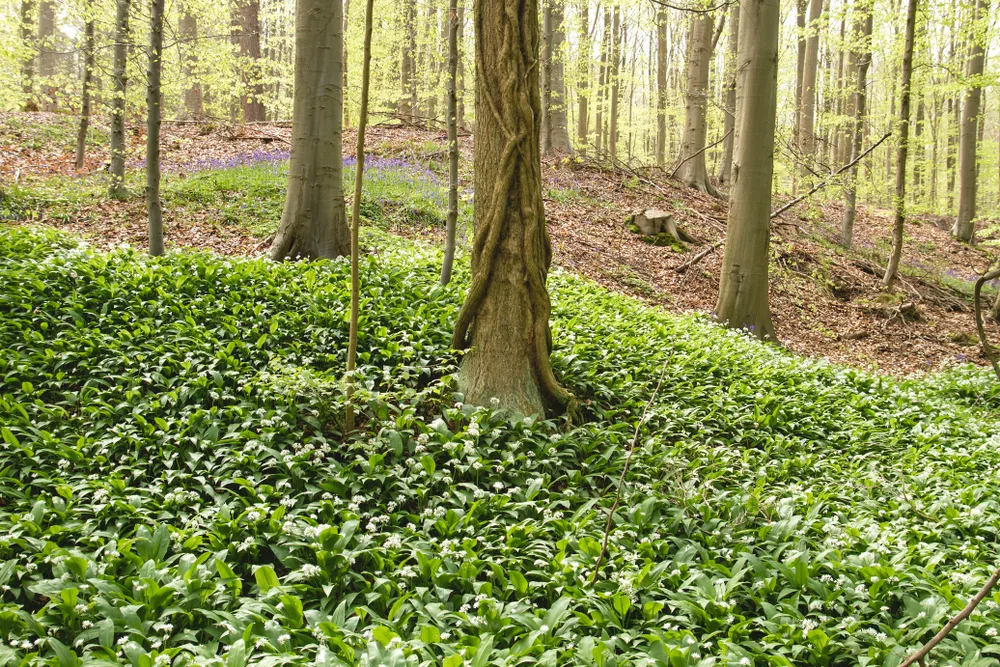
What are ramsons?
Going by their Latin name, they are Allium ursinum.
Common names range from wild garlic to bear garlic or bear leek, and from buckrams to broad-leaved garlic or just plain old ramps.
They are a wild relative of the onion, native to both temperate Europe and Asia where they can be found growing in many a moist woodland, but you won’t find them everywhere you wander, as they can be somewhat picky about the slightly acidic soils they choose to emerge from.
Nowadays, you can also forage for them in the Upper Midwest, all the way to the Appalachian mountain range and beyond.
Loved by wild boars and bears alike, you’ll have two options to try them out: get out in nature and forage for them fresh, or purchase from others who have been out foraging.
Either way, be sure to trust the hand that feeds you. While they are completely nutritious on their own right, they do have lookalikes to watch out for. We’ll get to that later on.
For starters, the best thing to do is learn to identify them correctly.
Identifying ramsons in the wild
Typically blanketing the ground from April to May, ramsons grow to a height of 8-10″ (25 cm). They can also appear much sooner than this, or somewhat later, it all depends on the weather and the warmth of the soil.
Ramsons can be easily recognized once they reach maturity, by their 6-tepaled star-like flowers.
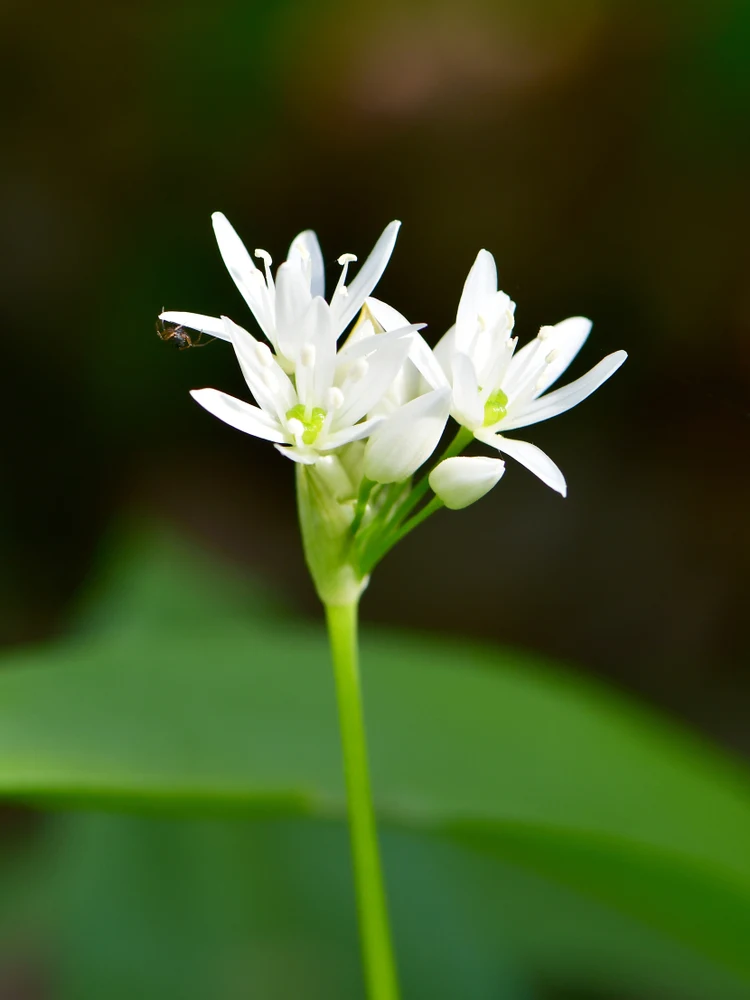
While the flower stems are delightfully edible and temptingly crunchy, by this time the leaves may be starting to lose some of their flavor and crispness. So, you’ll also need to identify the leaves to enjoy the entire wild garlic foraging-eating-harvesting experience.
Examine the leaves
It is not enough to just recognize the wild garlic leaves as being a particular shade of green.
Look at the direction of the veins and how they are attached to the stem. Lily of the valley (Convallaria majalis) has 2-3 leaves coming out of a single stem, whereas ramsons grow a bunch of stems with only one leaf per stem.
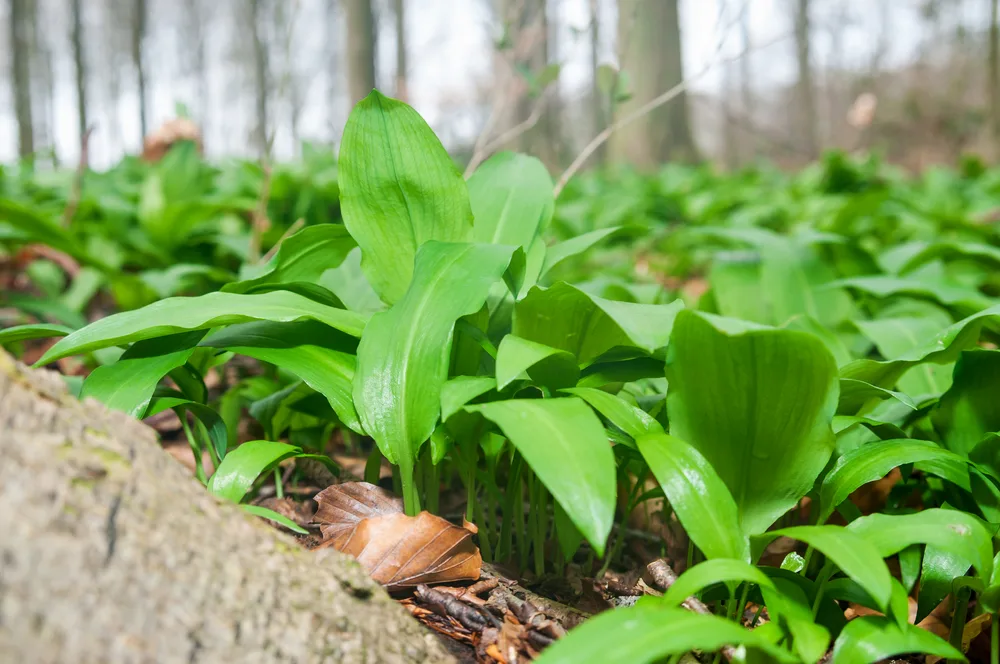
Another obvious difference is the flowers
If you have waited long enough to harvest, you will find that lily of the valley has fragrant flowers that smell of sweet perfume, rather than of food. The flowers resemble tiny white bells that drop to one side of the flowering stalk.
When you come upon a patch of ramsons in bloom, it will appear as a starry field. Each flower stem has several 6-tepaled flowers that are instantly recognizable. A wonderful sign that you are in the right place!
Smell test
The most obvious way to tell that ramsons are underfoot, is a smell test.
Grab a single leaf and rub between your fingers. Does it smell like garlic or chives? If yes, then you are onto something, say a wild garlic pesto?!
How to forage for wild garlic
Springtime is when you will find wild garlic emerging gracefully from the forest floor, one of the first edible greens outside of stinging nettle tops and cleavers.
Once you are able to identify ramsons, now you can pick them with care.
Before you get overexcited to grab the first greens, let’s cover some foraging basics.
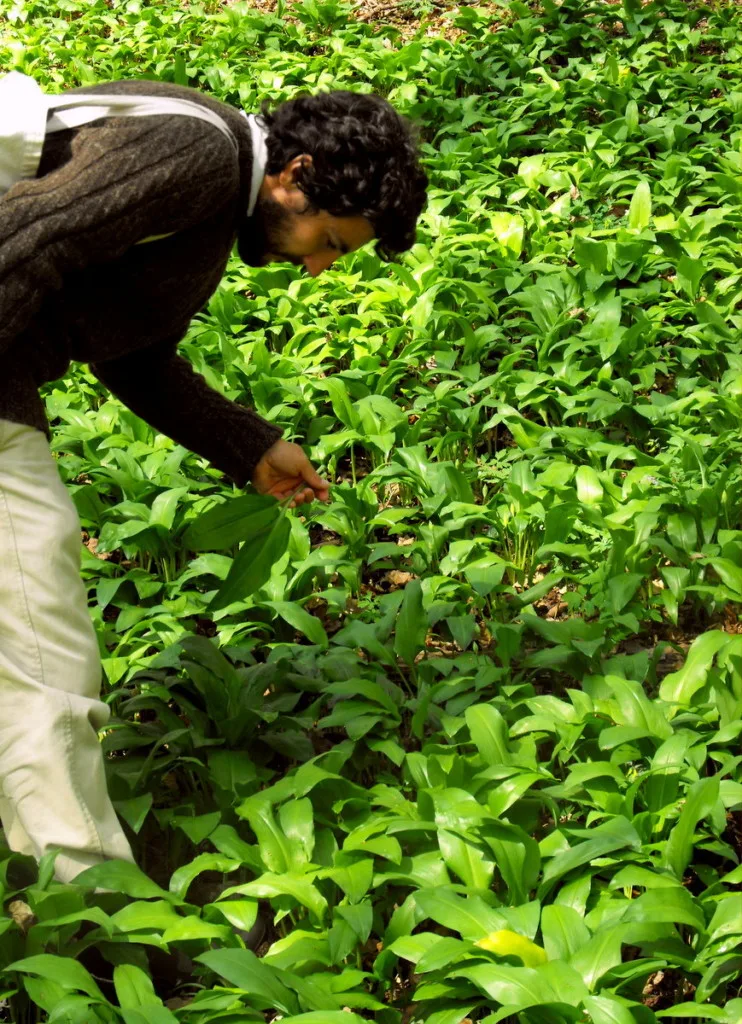
Location
If you are foraging on land that is not your own, be sure to ask for permission from the owner.
While you are out observing and asking questions, try to discern if any chemicals have been sprayed. If they have been, better move on and skip to another harvesting spot. Never eat anything that has been sprayed! This applies to dandelions and everything else that will be ingested.
Related Reading: 16 Brilliant Ways To Use Dandelion Flowers
At the same time, keep clear from busy roadsides where run-off and airborne pollution can be a potential problem.
Carry a few harvesting supplies
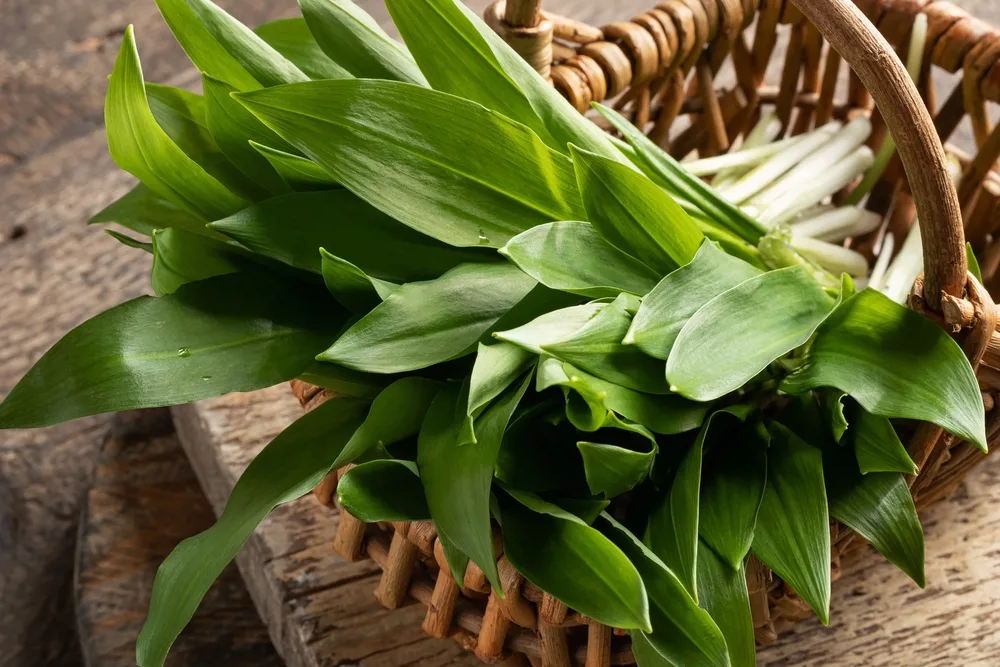
When the foraging bug hits you, you will be searching for (and finding!) free food everywhere.
All you need for a quick foraging trip is:
- a basket, bucket or other container
- pruners
- kitchen shears or small pocket knife
- gloves
- and a journal or notebook
Keeping track of where and when you find food – down to the exact location – is one way to keep your memory right on track, when it comes to future harvests.
Most of all, just go out and have fun!
And if you do happen to find a prolific secret spot full of ramsons, better keep it a secret!!
Harvesting wild garlic
It may be tempting to rip the wild garlic stems by hand, but harvesting with a knife is so much easier. Scissors work too.
And while it may be tempting to grab a bunch and run, harvesting the stems individually, actually doesn’t take that much time at all. Plus it promotes not overpicking – which is always a concern when foraging.
Cut the ramson stems close to the ground, and place them gently in a foraging basket or bag in an orderly fashion. This extra effort will be quite handy, come time to wash them.
Be sure to never harvest more than 1/3 of what you come across. Even less is a better answer. Take only what you need and leave plenty for nature and other insects and animals.
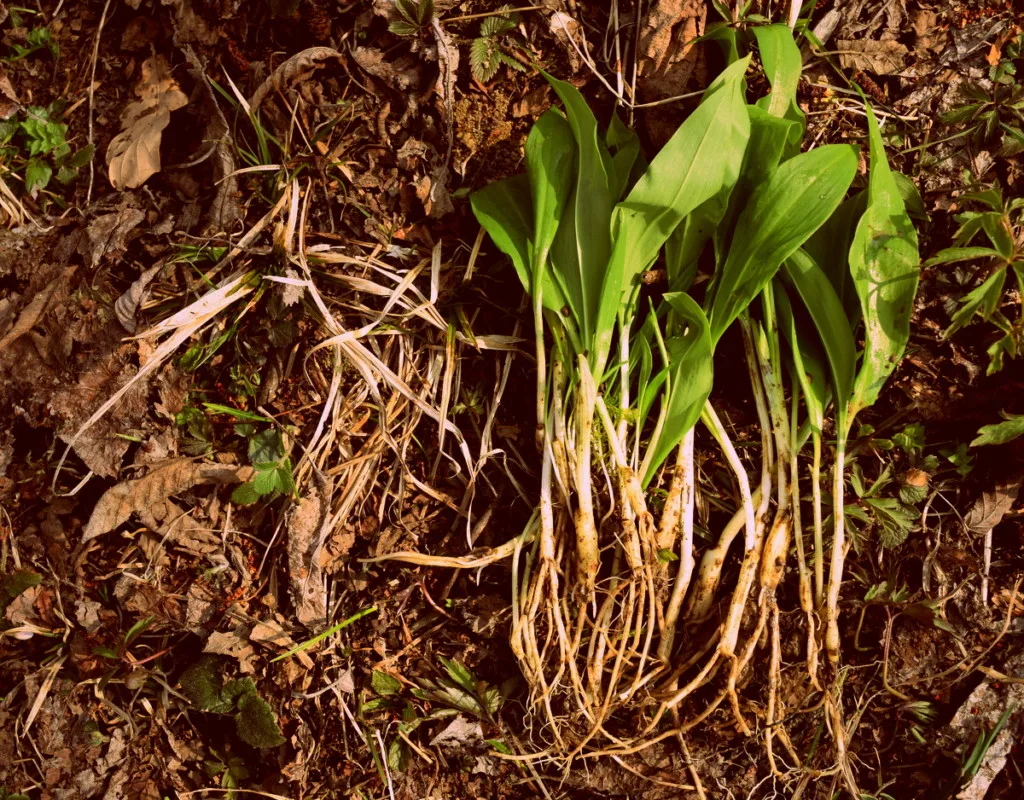
Also be mindful of not lifting up the bulbs, unless you are transplanting them. While they are edible, it is best to leave the bulb in the ground, so that the plant can recover from season to season.
If it is not illegal to dig wild garlic bulbs in your area, there may be a limit as to how many you can harvest each season, so be aware of local laws and obey the foragers’ code of ethics.
Did you know that ramsons are pollinated by hoverflies, bees, butterflies and longhorn beetles?
Cooking with ramsons
If you’ve never had the chance to chow down on some freshly foraged wild garlic, you are definitely missing out!
Make a special effort this year to go out and find some, or dine at a fancy restaurant for the chance to try it in season. But it is so easy to process and work with, I know that home-cooked will taste better every time. Not to mention much cheaper too.
All parts are edible
There are subtle differences within all parts of a single stem of wild garlic. In this way you can utilize the entire plant, wasting nothing.
Bulbs – while the bulbs are indeed edible, they are often very small, and better left in the ground to help ensure future harvests.
Leaves – are the main attraction of the plant. Use them as you would any other leafy vegetable, particularly spinach.

Stalks and flower buds – before the flowers open up, they are delightfully tender and crunchy all in one. They are the best part of the plant, if you are asking me – for fresh eating and stir fries! Stems and unopened flowers can be preserved by salting or pickling.
Flowers – once the flowers open, their flavor profile intensifies and their garlicky bite is stronger than that of the leaves.
Ripe fruit/seed pods -as ramsons mature, green seeds begin to form as the season is ending. Add them to salads or garlic butter to experience their true unique flavor.
The first way to eat ramsons is raw – as nature intended.
Roll the leaf up, or rip little by little starting at the tip, moving down to the crunchy stem. Or chop them up and add to salads and sandwiches.
The next logical step is to move onto wild garlic pesto.
It is important to note however, that once ramsons are harvested, they should be used within 1-2 days after collecting them.
They may keep for a couple of days longer by standing them in a jar of water in the fridge.
Wild garlic pesto
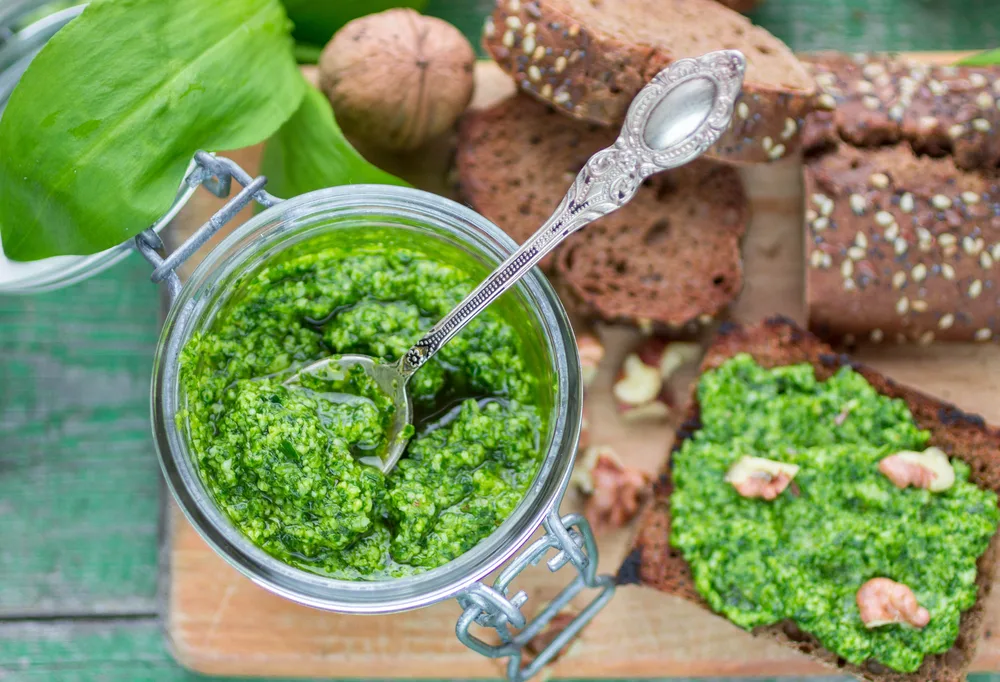
Perfect for dipping in, slathering on your BLT for a taste of a wild streak, or dolloped over a plate of pasta, wild garlic pesto is going to change your life – at least while you are eating lunch!
It is a fabulous way to use up loads of ramsons at once.
Then you can use your homemade wild garlic pesto in any recipe that would call for a traditional pesto:
- quesadillas
- omlettes
- cream cheese pesto
- salad dressing
- baked potato wedges
- pizza
I recommend you try both of the following recipes, before modifying ingredients to create your own:
Vegan Wild Garlic Pesto @ Lazy Cat Kitchen
Ramsons Pesto @ The Hedge Combers
And yes, it is possible to freeze wild garlic pesto! So you can save the fresh flavor of spring far into summer and autumn too.
Ramson sauce with mashed potatoes

One of my favorite savory dishes is sorrel sauce served with creamy mashed potatoes and baked duck. Ramsons emerge before sorrel, and they make an excellent substitution. The end result is still green, just slightly tart and completely mouthwatering.
Here are the ingredients to make it:
- 2/3 cups heavy cream
- 3 T. lard or butter
- 4 oz. ramsons (or one big fistful!)
- 3 T. chicken stock (or a vegetable one)
- 2 T. gluten-free flower (or thickener of your choice)
- pinch of salt
Wash the ramsons thoroughly, and cut them up finely. In one pot, add the cream and heat it up slowly. In another larger saucepan over medium heat, add the lard or butter, the thickener, then quickly toss in the greens. Stir them often until they “melt”.
Next, add the pre-warmed cream and thin it out with just as much stock as you wish. Serve it warm and indulge in the oniony-garlic flavor.
Wild garlic and potato soup
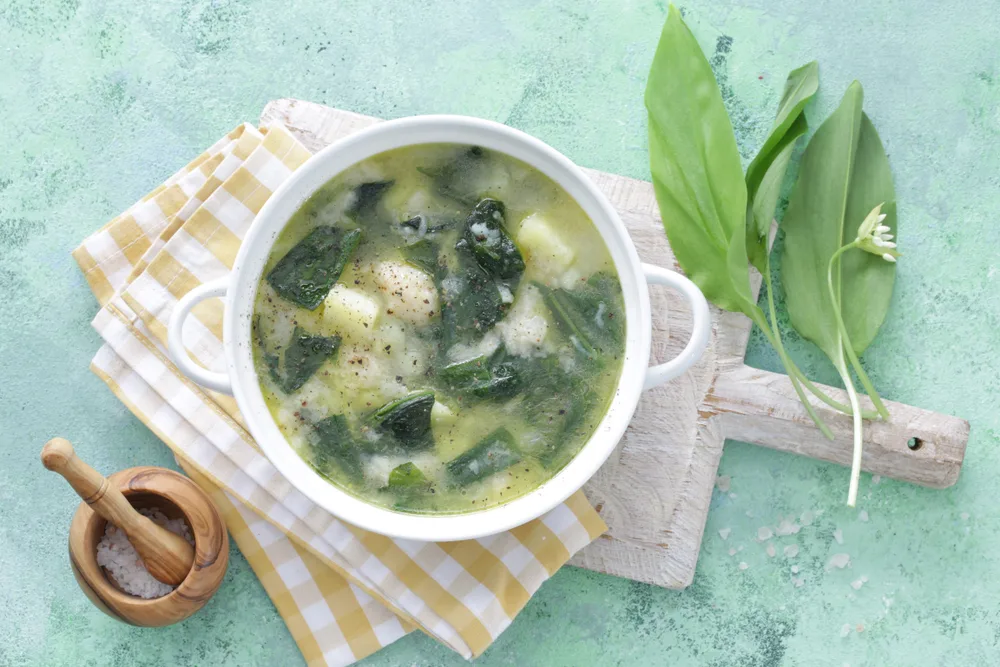
Another easy way to use up bunches of delicious ramps is in hearty soups and stews.
If by this time of year your homegrown, over-wintered potatoes are beginning to long for being planting in the soil once again, or you are just simply plain bored of eating away at your saved stash, enliven them with wild garlic. You’ll be overjoyed for a new, exciting recipe!
Wild Garlic Soup @ the Simple Things
Ramson Bread
Who can resist a fresh-from-the-oven slice of ramson bread with butter? Or – not to overdo it -, with ramson butter?
It’s simple. Just chop up the leaves fresh and add them to your favorite bread mix. Bake and enjoy.
Of course, you could also add some chopped wild garlic to cheesy muffins or quiches too. And the way they taste in a stir-fry? That is for you to decide.
Ramson Pull-Apart Bread @ Foodal
In many cases you can utilize fresh wild garlic where you would normally use spinach, chard, kale, sorrel, watercress or nettle.
Take it as an opportunity to get creative in the kitchen and learn something new from a plant that has stood the test of time.
Preserving wild garlic
As previously mentioned, wild garlic pesto can be frozen for your tasting pleasure later in the season.
We’ve also had great luck with dehydrating the leaves, just as you would air dry other herbs. They will lose some of their color in the process, fading to subtle shades of green and yellow, they will also lose some of their pungency.
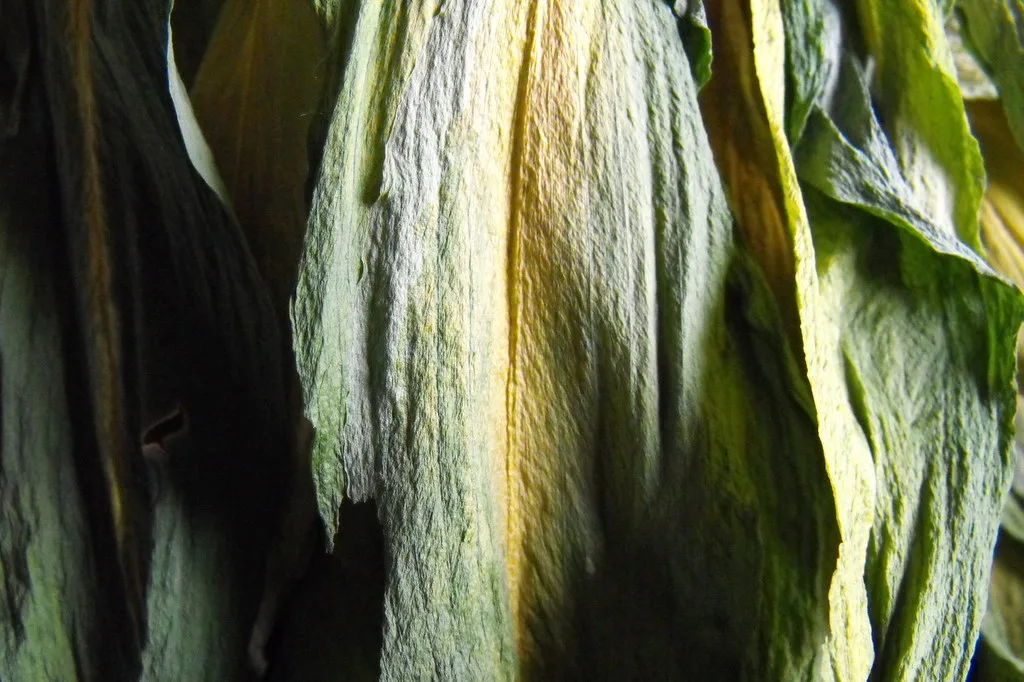
When working with wild foods, it is best to appreciate these changes, rather than fight against them. Even when dry, the leaves will be too strong for ripping. Use a pair of kitchen shears to cut them in smaller pieces to use in soups, stews and sauces. They are perfect in any dish where they can be rehydrated.
Ramsons can also be preserved in honey or vinegar, or preserved in chutneys and pickles.
Health benefits of ramsons
Many wild foods not only taste great, they are pure medicine and full of essential nutrients too, which may be lacking in your modern diet. This is especially so as we are just coming out of winter.
Not only that, it is rich in vitamin C and B vitamins, as well as calcium, magnesium and iron.
Wild garlic aids in detoxing the body, it supports heart health, and can be a wonderful treatment for the common cold and flu. If only you had it when you needed it most!
Not to be mistaken for poisonous plants!
Lily-of-the-valley often doesn’t escape out into the wild, though the leaves can look similar to ramsons to the untrained eye, will definitely make you sick if ingested.
Be sure to test as above, rubbing the leaves to determine that a leek-garlicky scent is present. If not, stop picking and thoroughly wash your hands before touching anything else!
However, lily of the valley does have its advantages as a plant that is deer and rabbit resistant, just as it does not need any winter or pruning care. It can help control erosion on heavily shaded slopes. and become a lush groundcover that is virtually maintenance-free.
It is best to avoid confusion and foraging disaster. Never plant these two species next to each other where there is a possibility to grab an extra (wrong) leaf.
Grab only what you want…
Solomon’s-seal (Polygonatum multiflorum) is another plant that can be mistaken for wild garlic with its oblong, oval untoothed leaves. However, the flowers will identify it differently.
While you are out there harvesting, you’ll soon realize that what looks like a blanket of ramsons, is actually a mixed bag of greens, though not what you would expect to find at the store!
You may find some stems of Lords and Ladies, or water hemlock dropwort as you go along cutting stems of wild garlic. These are both poisonous and should be avoided. The best way to do this is by harvesting stem-by-stem, or just a few at a time.
And when you get them home, double-check for any intruders in your foraging basket again, stem by stem, as you get ready to wash, eat and cook them.
Don’t be scared, just informed.
In order to regain a strong sense of self-reliance, we need to relearn to lean on ourselves (and Nature!) for providing food.
Foraging for ramsons is a wonderful and garlicky way to start!

Get the famous Rural Sprout newsletter delivered to your inbox.
Including Sunday ramblings from our editor, Tracey, as well as “What’s Up Wednesday” our roundup of what’s in season and new article updates and alerts.


